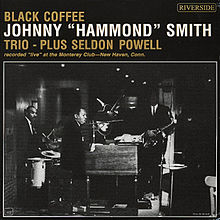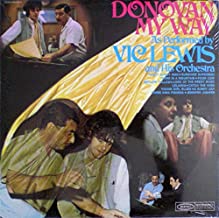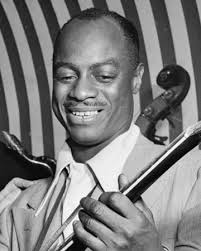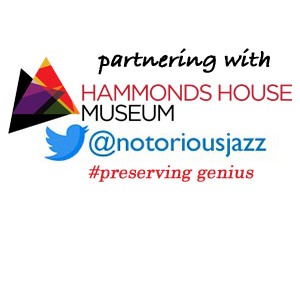
Daily Dose Of Jazz…
Eddie Lee McFadden was born on August 6, 1928 in Baltimore, Maryland and as a small child tried the piano but later settled on guitar. After his military service, he concentrated on jazz guitar. By the 1950s the guitarist was playing in Philadelphia, Pennsylvania clubs. From 1957-58 he was in organist Jimmy Smith’s band and recorded a dozen albums with Smith as part of a trio and sextet. The trio included Donald Bailey on drums.
Staying with organists he next joined Johnny “Hammond” Smith and during the period 1960–63 and one more in 1966, McFadden made eight recordings. Two further sideman appearances on albums came to fruition in the late 1970s.
In November 1967, the Al Grey & Eddie McFadden Quartet played at Count Basie’s Lounge in New York. During the late Seventies he recorded with Sonny Phillips and Don Patterson.
Guitarist Eddie McFadden, who also wrote music for some of his bands, passed away on September 23, 1992 in Philadelphia.
More Posts: bandleader,composer,guitar,history,instrumental,jazz,music

Daily Dose Of Jazz…
Victor Lewis was born on July 29, 1919 in London, England and began playing the guitar at the age of three, and dabbled with cornet and trombone. One of his early bands included George Shearing, then a teenager, among its members.
Lewis first toured the United States in 1938, where he recorded sessions with a band that had Bobby Hackett, Eddie Condon, and Pee Wee Russell. Serving in the Royal Air Force from 1941 to 1944, he recorded with Buddy Featherstonhaugh. While he was in the RAF, he met Jack Parnell and together they formed the Vic Lewis/Jack Parnell Jazzmen. He worked with Stephane Grappelli after the war and with Ted Heath soon after.
Lewis put together his first big band in 1946 to play swing jazz, but soon after its formation he began to direct the ensemble toward the sound of Stan Kenton, who gave him some of his arrangements by Pete Rugolo, Gerry Mulligan, and Bill Holman. Pianist Ken Thorne also made arranging contributions. He toured the US with the band at various intervals between 1956 and 1959, and recorded extensively for Parlophone, Esquire, Decca, and Philips.
After 1959, Vic semi-retired as a performer, only occasionally recording, but he continued to write about jazz and champion its value. He went into artist management, and oversaw the careers of photographer Robert Whitaker and the singer Cilla Black among many others.
Selling his management agency in 1964 to Brian Epstein’s company NEMS, then worked with Epstein arranging the Beatles’ international tours. Following Epstein’s death in 1967, Lewis served as managing director of NEMS. Lewis also managed Robin Gibb of the Bee Gees, and produced his debut album Robin’s Reign in 1970.
He conducted recordings of his own and others with the Royal Philharmonic Orchestra on Vocalion, which included excerpts from his Russian Suite, a Romance for Violin, and two movements (Red and Jade) from a multi-composer suite called Colours. Guitarist, bandleader, agent and manager Vic Lewis, who was awarded the MBE in 2007, continued to work in the music industry until he passed away on February 9, 2009 in Golders Green, London.
More Posts: agent,bandleader,guitar,history,instrumental,music

Daily Dose Of Jazz…
Albert Laurence Di Meola was born July 22, 1954 in Jersey City, New Jersey and grew up in Bergenfield, New Jersey where he got his education through high school. When he was eight years old, he was inspired by Elvis Presley and the Ventures to start playing guitar. His teacher directed him toward jazz standards.
Attending Berklee College of Music in the early 1970s, by nineteen he was hired by Chick Corea to replace Bill Connors in the pioneering jazz fusion band Return to Forever with Stanley Clarke and Lenny White. He recorded three albums with the band, all of which cracked the Top 40 U.S. Billboard pop albums chart. After the group disbanded in 1976, Al set out on a solo recording career demonstrating his mastery of jazz fusion, flamenco, and Mediterranean music.
His debut solo album Land of the Midnight Sun in 1976 led to his follow-up His 1977 sophomore album Elegant Gypsy that went gold. His early albums were influential among rock and jazz guitarists. He went on to explore Latin music within jazz fusion, the electronic side of jazz, and along with Jan Hammer and Jeff Beck composed the Miami Vice theme.
Throughout his career he explored his acoustic side, world music and modern Latin styles in addition to jazz and rediscovering his love of the electric guitar in 2006, In 2018, Di Meola was awarded an honorary doctorate of music from his alma mater, Berklee College of Music.
Guitarist Al Di Meola, who cites his jazz influences as guitarists George Benson, Kenny Burrell, Clarence White and Doc Watson, continues to push the envelope with his music.
More Posts: bandleader,composer,guitar,history,instrumental,jazz,music

Daily Dose Of Jazz…
Chuck Anderson was born in Chicago, Illinois on June 21, 1947. He began guitar lessons at the age of 14 and by 1963, he was teaching guitar and playing in a band.
At the age of 19, he began studies with Dennis Sandole, who was notable for his association with John Coltrane, James Moody, Michael Brecker, Pat Martino and Jim Hall.
In 1969, Anderson was offered the staff guitar job at the Latin Casino in Cherry Hill, New Jersey. The Latin was a popular venue before gambling came to Atlantic City. During that period, he accompanied and performed with Bobby Darin, Billy Eckstine, and Peggy Lee, playing fourteen shows a week.
By 1973 Chuck had returned to jazz and formed the Chuck Anderson Trio with Al Stauffer on bass and Ray Deeley on drums. Four years later, he was the staff guitar job at Valley Forge Music Fair in Devon, Pennsylvania.
During the years leading up to the Eighties he worked with Nancy Wilson, Michel LeGrand, and Anthony Newley. In the years that followed, he concentrated on teaching, composing, and session work.
He has written a column, The Art and Science of Jazz, for the web magazine All About Jazz. Guitarist, educator, composer, and author Chuck Anderson continues his career in music.
More Posts: author,composer,educator,guitar,history,instrumental,jazz,music

Three Wishes
When Tiny Grimes responded to Pannica’s inquiry, he only had a single wish:
- “I don’t need but one: security. Pay my rent, my automobile. The rest would take care of itself. Just give me a telephone, so I can get to my gigs.”
*Excerpt from Three Wishes: An Intimate Look at Jazz Greats ~ Compiled and Photographed by Pannonica de Koenigswarter
More Posts: baroness,guitar,history,instrumental,jazz,music,pannonica,three,wishes





